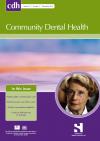Community Dental Health

- Cover Date:
- December 2015
- Vol:
- 32
- Issue:
- 4
Long term evaluation of the clinical effectiveness of community milk fluoridation in Bulgaria
Objective: To determine the clinical effectiveness of a community milk fluoridation programme. Basic research design: Parallel arm
5-year cohort study, with final cross-sectional comparisons between groups. Participants: 3-year-olds in 8 Bulgarian cities/towns entered the
cohort study with random samples (n=1,782) recruited at baseline in 2004. After 5 years in 2009 sub-samples (about 30%) of these now
aged 8 were randomly selected in intervention sites for follow-up examination (n=454); 276 controls were examined at the age 8 years.
For cross-sectional comparisons, in 2004, 284 3-year-olds from control cities were baseline examined for caries, then 276 children at the
age 8 years in 2009. Interventions: In six intervention communities: 1,498 examined children received 0.5mg F in 100 or 200ml school
milk or yogurt provided each school day; a further 180 received non-fluoridated milk. In two control communities, fluoride was not added
to 284 children’s school milk. Main outcome measures: Dental caries experience of primary, and permanent teeth. Results: For primary
teeth, caries increments were 46% (p<0.001) and 30% (p<0.01) lower in the fluoridated milk groups compared with non-fluoridated milk
groups in the intervention and control communities, respectively. For permanent teeth those reductions were 61% and 53% (p<0.001).
The cross-sectional comparisons of 8-year-olds showed significant changes in dental caries experience over time; in children consuming
fluoridated milk the level of dmfs fell by 43% (2004 and 2009) against 11% in the control group. Among children consuming fluoridated
milk the DMFS fell 68% against rising 3% in the controls. Conclusions: Fluoridated milk delivered daily in schools in Bulgaria resulted
in substantially lower caries development compared with children in schools receiving milk without added fluoride. The nation-wide experiences from milk fluoridation indicate that such a public health scheme can be effective to the global fight against dental caries of children.
Key words: dental caries prevention; fluoridated milk; cohort study; children; Bulgaria
- Article Price
- £15.00
- Institution Article Price
- £
- Page Start
- 199
- Page End
- 203
- Authors
- P.E. Petersen, S. Kwan, H. Ogawa
Articles from this issue
- Title
- Pg. Start
- Pg. End
- The feasibility of using an alcohol screening tool in a UK dental setting to identify patients’ alcohol consumption
- 196
- 198
- Long term evaluation of the clinical effectiveness of community milk fluoridation in Bulgaria
- 199
- 203
- Time trends and determinants of acute odontogenic maxillofacial infections in Lithuania: a retrospective national 2009-2013 treatment data audit
- 209
- 215
- Dental anxiety and oral health in 15-year-olds: a repeated cross-sectional study over 30 years
- 221
- 225
- Development and evaluation of a Dental Patient Feedback on Consultation skills (DPFC) measure to enhance communication
- 226
- 230
- A retrospective audit of population service access trends for cleft lip and cleft palate patients
- 237
- 240
- Caregiver financial distress, depressive symptoms and limited social capital as barriers to children’s dental care in a midwestern county in the United States
- 252
- 256
